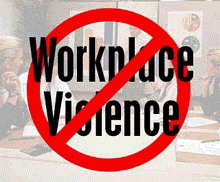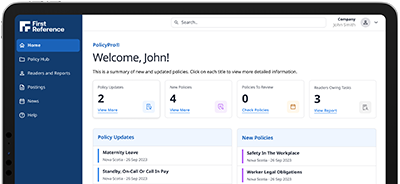
Complying with workplace violence and harassment laws in Ontario and beyond
First Reference
Canadian employers are under increasing pressure to comply with complex and evolving workplace violence and harassment laws. What once required little more than a policy on paper now demands a well-structured, actively implemented prevention program—especially for organizations operating across multiple provinces.
In Ontario, the Occupational Health and Safety Act (OHSA) establishes the legal framework for workplace violence and harassment prevention. But every province and territory in Canada has its own legislation, each with specific nuances. Understanding and complying with these requirements isn’t optional—it’s essential for protecting your workers, minimizing liability, and maintaining a productive work environment.
Understanding the legal framework
Under sections 32.0.1 to 32.0.7 of Ontario’s OHSA, employers must implement a workplace violence and harassment program that includes:
- A written policy and reporting procedure
- Risk assessments and control measures
- Training for workers
- Clear investigation and resolution processes
The OHSA definitions are broad. Workplace violence includes the exercise, attempted exercise, or threat of physical force. Workplace harassment includes vexatious conduct that causes harm to a worker’s psychological or physical well-being. Employers must also consider how domestic violence can pose risks in the workplace.
Other provinces follow similar principles, but compliance requirements, investigation protocols, and timelines vary. For federally regulated employers, the Canada Labour Code provides its own parallel obligations—adding another layer of complexity for organizations that operate nationally.
Key compliance requirements
1. Risk assessments
Employers must regularly assess the workplace for risks related to violence and harassment. This means evaluating not just physical safety, but also work practices, interpersonal dynamics, and environmental stressors. Documentation and periodic reviews are essential.
2. Policy development and implementation
Policies should clearly define prohibited behaviours, outline reporting mechanisms, explain how complaints will be investigated, and state consequences for violations. These policies must be communicated to all employees and easily accessible.
3. Training and awareness
All employees—from frontline staff to managers—must receive training tailored to their roles. This includes recognizing warning signs, understanding reporting options, and knowing how to respond appropriately. Refresher training should be conducted regularly.
4. Investigation and resolution
Employers must respond to every complaint with a prompt, impartial, and confidential investigation. Investigations must be conducted according to a consistent, transparent process, and employers must protect complainants from reprisal while addressing any findings with appropriate corrective action.
Multi-jurisdictional challenges
Organizations operating in more than one province or territory must reconcile a patchwork of legislative standards. While foundational principles are consistent, operational details—such as training content, documentation requirements, and enforcement mechanisms—can vary widely.
Adding to the complexity is the evolving nature of the law itself. Courts and regulators continue to refine expectations through case law, compliance bulletins, and guidance materials. For HR and payroll professionals, staying ahead of these developments requires dedicated time and resources.
How First Reference helps
First Reference offers two trusted tools to help organizations implement and maintain compliant violence and harassment prevention programs:
The Human Resources Advisor
The Human Resources Advisor provides clear, plain-language guidance on legal obligations across all 14 Canadian jurisdictions. With this resource, HR professionals can:
- Access up-to-date summaries of relevant laws and regulations
- Understand key differences between jurisdictions
- Review compliance checklists, case law, and best practices
- Receive timely updates on legal changes and enforcement trends
PolicyPro
PolicyPro supports policy creation and maintenance with ready-to-use, legally reviewed templates. Its workplace violence and harassment materials include:
- Customizable policies aligned with current legislation
- Implementation guides and communication tools
- Multi-jurisdictional policy options for national employers
- Automatic updates when laws change
Together, these tools provide a proactive compliance foundation—backed by ongoing expert support.
Best practices for compliance
- Regular policy reviews – Your policy is only as good as its alignment with current law. Schedule annual reviews and make updates immediately after legislative changes or workplace incidents.
- Foster a culture of respect – Compliance starts with culture. Promote respectful interactions, recognize positive behaviour, and train supervisors to lead by example. A healthy workplace culture deters misconduct and supports early intervention.
- Maintain accurate documentation – Keep detailed records of training, complaints, investigations, and corrective actions. Strong documentation supports internal accountability and legal defensibility in the event of an external audit or legal dispute.
- Be proactive – Don’t wait for an incident to act. Analyze trends, assess emerging risks, and use anonymous surveys to gauge workplace climate. Proactive risk management helps identify issues before they escalate.
The cost of non-compliance
Failing to meet legal obligations can result in:
- Regulatory investigations and penalties
- Civil lawsuits and settlement costs
- Higher workers’ compensation premiums
- Loss of employee trust and morale
- Reputational damage in the media and public
These consequences can be far more costly than investing in a robust compliance program.
Looking ahead: emerging compliance considerations
Employers should prepare for new risks and expectations, including:
- Virtual harassment and bullying in hybrid or remote work environments
- Greater emphasis on psychological safety and mental health
- Use of digital reporting and monitoring tools
- Recognition of intersectional factors in harassment cases
- Increased scrutiny from regulators and employee advocacy groups
Final thoughts
Preventing workplace violence and harassment is more than a legal requirement—it’s a cornerstone of a safe, productive workplace. But in a multi-jurisdictional, rapidly evolving regulatory environment, meeting compliance obligations can be challenging.
That’s where First Reference comes in. With The Human Resources Advisor and PolicyPro, your organization gains trusted resources that deliver expert-reviewed guidance, templates, and updates, so you can act with confidence.
The return on investment is clear: reduced risk, improved workplace culture, and peace of mind for employers and employees alike.
To learn more about how First Reference can support your compliance efforts, contact our team today. With decades of experience and a reputation for excellence, we’re your trusted partner in building safer, more compliant workplaces across Canada.
Table of Contents
Compliance Made Easy®

